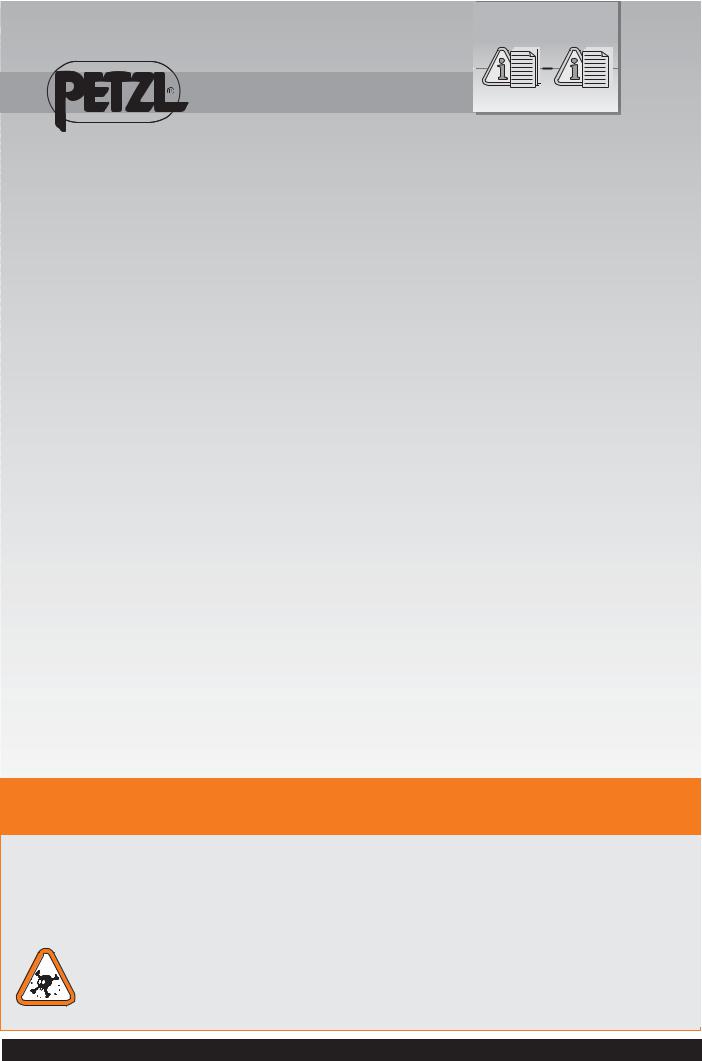Petzl LASER SONIC User Manual [en, ru, de, es, fr, it, cs, pl]

|
Product |
|
|
information = |
|
Specific information |
specific |
general |
|
information |
information |
(GB) IMPORTANT |
(PT) IMPORTANTE |
(RU) ВАЖНАЯ |
(BG) ВАЖНО |
This notice contains information and |
Esta notícia contém unicamente |
ИНФОРМАЦИЯ |
Тази листовка съдържа само |
instructions specific to this product |
informações específicas para este |
Эти материалы содержат |
специфичната информация и |
only, for complete product information, |
producto. Para ter uma informação |
специальную информацию, которая |
указания за употреба на този |
see also the attached Petzl General |
completa, veja também a notícia das |
имеет отношение только к данной |
продукт. За да получите пълна |
Information notice. Both notices must |
Informações Gerais para todos os |
продукции. Для получения полной |
информация, вижте също |
be read and understood before using |
produtos Petzl. As duas notícias deve |
информации обратитесь к заметкам |
листовката ”Обща информация” |
this product. |
ser lidas e compreendidas antes de |
содержащим Общую Информацию |
отнасяща се до всички продукти |
(FR) IMPORTANT |
utilizar este produto. |
Petzl (прилагается). Пожалуйста, |
на Петцл. Преди да започнете да |
Cette notice contient uniquement des |
(NL) BELANGRIJK |
прочитайте и осознайте обе части |
употребявате този продукт, трябва |
informations spécifiques à ce produit. |
Deze bijsluiter bevat enkel de specifieke |
инструкции перед тем, как начнёте |
да прочетете и разберете и двете |
Pour avoir une information complète, |
informatie voor dit product. Voor |
использовать эту продукцию. |
листовки. |
voir aussi la notice des Informations |
een volledige informatie, zie ook de |
(CZ) DŮLEŽITÉ |
(JP) |
générales à tous les produits Petzl. |
bijsluiter met de Algemene Inlichtingen |
Tento návod obsahuje informace, které |
|
Les deux notices doivent être lues et |
bijgevoegd bij alle Petzl producten. |
jsou určeny pouze pro tento výrobek. |
|
comprises avant d’utiliser ce produit. |
Beide bijsluiters moeten worden gelezen |
Pro úplnější informace použijte |
|
(DE) WICHTIG |
en begrepen alvorens dit product te |
přiložené Všeobecné informace firmy |
|
Diese Gebrauchsanweisung |
gebruiken. |
Petzl. Před použitím tohoto výrobku |
|
enthält wichtige Informationen und |
(DK) VIGTIGT |
jste povinni se seznámit s obsahem |
|
Anweisungen, die nur für dieses |
Denne brugsanvisning indeholder |
obou dokumentů. |
|
Produkt gelten. Weitere Informationen |
specifikke informationer og instruktioner |
(PL) UWAGA |
|
zu allen Produkten finden Sie der |
kun for dette produkt, for at fuldende |
Niniejsza instrukcja zawiera wyłącznie |
|
allgemeinen Petzl-Produktbeschreibung. |
produktinformationen, se vedlagte Petzl |
informacje właściwe dla tego produktu |
|
Vor der Verwendung dieses Produkts |
overordnende brugsanvisning. Begge |
W celu uzyskania kompletnych |
(KR) |
müssen beide Dokumente gelesen und |
brugsanvisninger bør læses og forstås |
informacji należy zapoznać się |
|
inhaltlich verstanden werden. |
før ibrugtagning af dette produkt. |
instrukcją Informacje ogólne dla |
|
(IT) IMPORTANTE |
(SE) VIKTIGT |
wszystkich produktów Petzl. Należy |
, |
Questa nota informativa contiene |
Detta informationsblad innehåller |
przeczytać i zrozumieć obydwie |
|
informazioni specifiche di questo |
information och instruktioner som |
instrukcje zanim zacznie się używać ten |
. |
prodotto soltanto. Per avere |
är specifika för denna produkt. För |
produkt. |
|
un’informazione completa, fate |
komplett produktinformation, se även |
(SI) POMEMBNO |
. |
riferimento anche alla nota informativa |
den bifogade allmänna informationen |
Ta navodila vsebujejo informacije, |
(CN) |
generale di tutti i prodotti Petzl. |
från Petzl. Bägge informationsbladen |
ki se nanašajo samo na ta izdelek. |
|
Entrambe le note informative vanno lette |
måste läsas och all information måste |
Za popolnejše informacije o izdelku |
|
e comprese prima di utilizzare questo |
förstås innan produkten används. |
preberite tudi Splošne informacije |
Petzl |
prodotto. |
(FI) TÄRKEÄÄ |
Petzl, ki so priložene. Pred uporabo |
|
(ES) IMPORTANTE |
Tämä ohje käsittää tietoa ja käyttöohjeita |
izdelka morate prebrati in razumeti obe |
|
Esta ficha técnica contiene únicamente |
nimenomaan tästä tuotteesta. Lue myös |
navodili. |
|
información específica de este |
oheen liitetty, yleinen Petzl informaatio. |
(HU) FIGYELEM |
(TH) БХ¤ЗТБЛБТВ |
producto. Para una información |
Molemmat ohjeet on luettava ja |
Ez a használati utasítás kizárólag |
¢йН¤ЗТБаµЧН¹НС¹¹ХйºГГ¨ШаГЧиН§¤Уб |
completa, consulte también la ficha de |
ymmärrättevä ennen tuotteen käyttöä. |
a termékre vonatkozó speciális |
¹Р¹У бЕР¢йНБЩЕ¾ФаИЙ¢Н§¼ЕФµАС³ |
Información general incluida en todos |
(NO) VIKTIG |
információkat tartalmazza, és csak |
±м¹ХйКУЛГСº¢йНБЩЕ¼ЕФµАС³±м·ХиКБºЩГ³м, |
los productos Petzl. Las dos fichas |
Denne bruksanvisningen inneholder kun |
az összes Petzl termékre vonatkozó |
ãËé´Ù·Õè¤Óá¹Ð¹Ó·ÑèÇ仢ͧ Petzl |
técnicas deben leerse y entenderse |
informasjon og instruksjoner spesifikt |
Általános információkkal együtt |
·ÕèṺÁÒ ¤Óá¹Ð¹Ó·Ñé§ÊͧÍѹÍѹµéͧ |
antes de utilizar este producto. |
for dette produktet. For komplett |
nyújt elégséges tájékoztatást. A |
Íè¹ áÅзӤÇÒÁà¢éÒ㨠¼ÅÔµÀѳ±ì¹Õé. |
|
produktinformasjon, vennligst se den |
termék használatbavétele előtt |
|
|
generelle bruksanvisningen fra Petzl. |
elengedhetetlen a két ismertető alapos |
|
|
Begge bruksanvisningene må leses og |
áttanulmányozása és megértése. |
|
|
forstås før produktet tas i bruk. |
|
|
 WARNING
WARNING
Activities involving the use of this product are inherently dangerous. You are responsible for your own actions and decisions.
Before using this product, you must :
-Read and understand all Product Information.
-Become acquainted with the product’s capabilities and limitations.
-Understand and accept the risks involved. Additionally, you should get qualified instruction in its proper use.
FAILURE TO HEED ANY OF THESE WARNINGS MAY RESULT IN SEVERE INJURY OR DEATH.
1 Notice P70 LASERSONIC réf. : P70500-B

www.petzl.com
LASER
LASERSONIC
(EN) Ice screw
(FR) Broches à glace
(DE)Eisschraube
(IT) Chiodo da ghiaccio
(ES) Tornillo de hielo
Made in France
3 year guarantee Patented
S |
M |
L |
XL |
100 mm |
130 mm |
170 mm |
210 mm |
|
0197 |
0197 |
0197 |
|
UIAA |
UIAA |
UIAA |
LASER |
|
|
|
P71 100 |
P71 130 |
P71 170 |
P71 210 |
128 g |
146 g |
164 g |
184 g |
LASERSONIC |
|
|
|
P70 100 |
P70 130 |
P70 170 |
P70 210 |
149 g |
165 g |
185 g |
205 g |
Nomenclature of parts
1a 1b
2
3
1. Maintenance
2. Strength - Test |
|
|
|
|
ICE |
|
|
(UIAA |
UIAA |
15 kN |
Definition) |
3. Placement
90°
Ice Rock
4. Advice on placement
5. Removal
LASERSONIC
MULTIHOOK 04950

 0197
0197

 0197
0197
(EN) Body controlling the manufacturing of this PPE
(FR) Organisme contrôlant la fabrication de cet EPI
(DE) Organismus der die Herstellung dieses PSA kontrolliert
(IT) Organismo che controlla la fabbricazione di questo DPI
(ES) Organismo controlador de la fabricación de este EPI
APAVE SUD EUROPE - BP193 - 13322 MARSEILLE Cedex 16
(EN) Notified body intervening for the CE type testing examination
(FR) Organisme notifié intervenant pour l’examen CE de type
(DE) Zertifikationsorganismus für CE Typen Überprüfung
(IT) Ente riconosciuto che interviene per l’esame CE del tipo
(ES) Organismo notificado que interviene en el examen CE de tipo
2 Notice P70 LASERSONIC réf. : P70500-B
UIAA
(EN) Quality label of the UIAA
(Union International des Associations d'Alpinisme).
(FR) Label de qualité de l'union internationale des associations d'alpinisme.
(DE) Qualitätslabel der UIAA
(Union International des Associations d'Alpinisme).
(IT) Label di qualità dell'Unione Internazionale delle Associazioni di Alpinismo.
(ES) Atestado de calidad de la UIAA (Union International des Associations d'Alpinisme).

(GB) ENGLISH
(GB) Ice screw
Limitations on use
Petzl Charlet ice screws conform to the safety requirements of the 89/686/CE directive on personal protective equipment (PPE) and to the UIAA requirements with the exception of the 100 mm versions (ice screws for direct aid only, not intended for protection against falls from height).
Nomenclature of parts
(1a) Attachment point only,
(1b) Attachment point with integral rotating crank, (2) Tube, (3) Drill bit.
Principal materials: chrome molybdenum steel.
Checking, points to verify
Before each use, carry out a visual check of the condition of the ice screw. If you note any cracks, twisting of the tube, deformation of the drill bit or any other structural anomaly, do not use the ice screw.
Diagram 1. Maintenance
After each use, dry out your ice screws. Spray with a lubricant in order to prevent corrosion and facilitate clearing of the tube.
Regularly check the sharpness of the teeth of the drill bit and sharpen them carefully as necessary. Use only a file, taking care not to modify the geometry of the cutting edges. Sharpening is a delicate operation, carrying the risk of noticeably affecting the performance of your ice screws.
Instructions for use
Diagram 2. Strength
The CE directive requires a minimum pull-out strength of 10 kN. The UIAA requires a minimum of 15 kN. Do not confuse the strength of the screw under testing conditions with the holding power of the screw under actual conditions of use. The latter can vary according to the quality of the ice. In general, the quality of the ice improves with depth.
Diagram 3. Placement
Choose the thickest and most homogeneous ice possible. Choose the length of the ice screw according to the thickness. WARNING, do not
force if the ice screw touches the rock as this can seriously damage the drill bit.
Diagram 4. Advice on placement
Clean away poor ice or unconsolidated surface ice in order to find homogeneous, solid ice. Position yourself in order to have the elbow bent at 90° and the hand at hip level. This is optimal for efficient application of force and precision. Use the rule of three to start:
-strike three times (position of the tube at 90°),
-turn three times “there and back“, clear the tube if necessary,
-Make three complete turns clockwise.
Screw in the ice screw completely, as far as the attachment point, with the aid of the crank. A continuous cylinder of ice should emerge from the screw.
Place an ice screw immediately upon leaving the belay to reduce the fall factor. Aim to reduce the potential impact force on the ice screw by careful management of the path followed by the rope.
Use a NITRO energy absorbing quickdraw to reduce the impact force.
Our ice screws have a polished finish to reflect the solar radiation as much as possible, so reducing heating of the metal. WARNING over a long period of exposure to the sun’s rays (toprope anchors for example) the holding power of the ice screw can be reduced (because of the heating effect).
Diagram 5. Removal
Turn the screw manually in an anticlockwise direction. The LASER SONIC is impossible to drop on removal as long as it remains attached to the rope.
Remove the cylinder of ice inside the screw (blocking the tube of the screw) by tapping the attachment point, straightaway if possible. Never tap on the threads as this can cause damage.
If the ice cylinder is jammed in, use the MULTIHOOK threading tool, without scratching the inside of the tube.
Carrying (walking in and out)
Replace the end covers after use to protect the drill bit as well as the rest of your equipment which could be damaged by the sharp teeth. Use of a storage bag (e.g. FAKIR) is recommended.
3 Notice P70 LASERSONIC réf. : P70500-B

(FR) FRANCAIS
(FR) Broche à glace
Champ d’application
Les broches à glace Petzl Charlet sont conformes aux exigences de sécurité de la directive 89/686/CE relative aux équipements de protection individuelle (EPI) et aux exigences UIAA à l’exception des versions S de 100 mm de long (broches de progression ne protégeant pas contre les chutes de hauteur).
Nomenclature des pièces
(1a) Patte d’accrochage seule, (1b) Plaquette manivelle rotative, (2) Tube, (3) Trépan. Matériaux principaux : acier chrome molybdène.
Contrôle, points à vérifier
Contrôlez visuellement avant chaque utilisation, l’état de la broche. Si elle présente une fissure, un tube tordu, un trépan déformé ou toute autre anomalie structurelle, ne plus utiliser cette broche.
Schéma 1. Entretien
Après chaque utilisation, séchez vos broches. Pulvérisez un lubrifiant afin de prévenir la corrosion et faciliter le débourrage du tube. Vérifiez régulièrement l’affûtage des dents du trépan et au besoin les aiguiser soigneusement. Utilisez exclusivement une lime en respectant bien les angles d’attaque (ou dépouille). L’aiguisage est une opération délicate qui risque de modifier sensiblement les performances de vos broches.
Prescriptions d’utilisation
Schéma 2. Résistance
L’exigence de la directive CE pour le test de résistance à l’arrachement est au minimum de 10 kN. L’exigence UIAA est au minimum de 15 kN. Ne confondez pas la résistance de la broche dans le cadre des tests et la tenue de la
broche dans la glace sur le terrain. Celle-ci peut varier en fonction de la qualité de la glace. En général, la qualité de la glace s’améliore avec la profondeur.
Schéma 3. Emplacement
Choisissez la glace la plus homogène et la plus épaisse possible. Choisissez la longueur de la broche en fonction de l’épaisseur. ATTENTION, ne forcez pas si la broche touche le rocher. Cela peut gravement endommager le trépan.
Schéma 4. Conseils pour brocher
Nettoyez la mauvaise glace ou glace de surface non consolidée afin de trouver la glace homogène et solide. Placez-vous de façon à avoir le coude plié à 90° et la main à hauteur de hanche. Vous conservez ainsi force et précision.
Appliquez la règle des 3 pour amorcer :
-tapez 3 fois (position du tube à 90°),
-tournez 3 fois «aller et retour», nettoyez si besoin le tube,
-faites 3 tours dans le sens des aiguilles d’une montre.
Vissez la broche à fond jusqu’à la patte, à l’aide de la manivelle. Une carotte de glace continue doit sortir de la broche.
Posez une broche immédiatement au départ du relais pour diminuer le facteur de chute. Veillez à réduire la force de choc potentielle sur la broche en gérant au mieux le trajet de la corde. Utilisez une dégaine absorbeur NITRO pour diminuer la force de choc.
Nos broches sont brillantes pour réfléchir au maximum le rayonnement solaire et limiter l’échauffement du métal. ATTENTION sur une longue période d’exposition au soleil (exemple ancrages de moulinette) la tenue de la broche peut diminuer (à cause de l’échauffement).
Schéma 5. Débrocher
Tournez manuellement en sens inverse des aiguilles d’une montre. La broche LASER SONIC présente l’avantage d’être imperdable au débrochage si vous la laissez accrocher à la corde.
Retirez la carotte de glace (qui bouche le tube de la broche) en tapotant sur la patte, si possible tout de suite. Ne tapez jamais sur le filetage cela l’endommagerait.
Si la carotte est coincée, utilisez le crochet à lunules MULTIHOOK sans rayer l’intérieur du tube.
Transport (marche d’approche)
Remettez les bouchons après utilisation pour protéger le trépan ainsi que le reste de votre matériel qui risquerait d’être perforé.
Il est conseillé d’utiliser un sac de rangement (ex. FAKIR).
4 Notice P70 LASERSONIC réf. : P70500-B

(DE) DEUTSCH
(DE) Eisschraube
Anwendungsbereich
Petzl Charlet Eisschrauben entsprechen den Sicherheitsvorschriften gemäß der Richtline 89/686/CE für persönliche Schutzausrüstung (PSA) sowie den Anforderungen der UIAA, mit Ausnahme der 10 cm langen S Versionen (diese Eisschrauben dienen lediglich der Fortbewegung und schützen nicht vor Stürzen aus der Höhe).
Benennung der Teile
(1a) Einfache Lasche, (1b) Lasche mit integrierter Kurbel, (2) Röhre, (3) Bohrzähne.
Material : Chrommolybdänstahl.
Überprüfung, zu kontrollierende Punkte
Führen Sie vor jedem Einsatz eine visuelle Überprüfung der Eisschraube durch. Sollten Ihnen Risse, Verformungen an der Röhre oder den Bohrzähnen und sonstige strukturelle Anomalien auffallen, verwenden Sie die Eisschraube nicht.
Abbildung 1. Pflege
Trocknen Sie die Eisschrauben nach jeder Verwendung. Tragen Sie ein Schmiermittel auf, um Korrosion zu vermeiden und um die Röhre leichter entleeren zu können.
Überprüfen Sie regelmäßig die Schärfe der Bohrzähne und feilen Sie sie, sofern erforderlich. Verwenden Sie ausschließlich eine Handfeile und achten Sie darauf, die Geometrie der Schneidkanten nicht zu verändern. Das Feilen ist ein Vorgang, der viel Sorgfalt erfordert. Hierbei
besteht das Risiko, die Leistung der Eisschrauben negativ zu beeinflussen.
Gebrauchsanweisung
Abbildung 2. Festigkeit
Gemäß dem CE-Standard ist eine Mindestfestigkeit von 10 kN erforderlich. Gemäß der UIAA sind mindestens 15 kN erforderlich. Verwechseln Sie nicht die Festigkeit einer Eisschraube unter Testbedingungen mit der tatsächlichen Festigkeit der Schraube unter normalen Anwendungsbedingungen. Letztere können Fallweise stark voneinander abweichen, je nach Qualität des Eises. Normalerweise verbessert sich die Eisqualität in der Tiefe.
Abbildung 3. Setzen einer Eisschraube
Wählen Sie die Länge der Eisschraube unter Berücksichtigung der Dicke. Setzen Sie Eisschrauben möglichst in dickes und
homogenes Eis. ACHTUNG: Versuchen Sie nicht, eine Eisschraube mit Gewalt weiterzudrehen, wenn diese auf Fels stößt, da hierbei die Bohrzähne beschädigt werden können.
Abbildung 4. Weitere Hinweise zum Setzen von Eisschrauben
Säubern Sie die Eisoberfläche von brüchigem Eis und sonstigen Unebenheiten, um homogenes und solides Eis zu finden. Positionieren Sie sich so, dass Sie die Schraube mit etwa 90° gebeugtem Ellbogen auf Hüfthöhe eindrehen können.
Diese Stellung ist optimal für den effektiven Umsatz von Kraft und Genauigkeit. Verwenden Sie zum Starten die Dreierregel:
-Stoßen Sie drei Mal (Röhrenposition = 90°),
-Drehen Sie die Röhre drei Mal vorwärts und
rückwärts und entlehren Sie sie, falls erforderlich, - Führen Sie drei vollständige Umdrehungen im Uhrzeigersinn durch.
Drehen Sie die Eisschraube vollständig bis zur Lasche in das Eis ein. Verwenden Sie hierfür eine Kurbel. Aus der Röhre der Eisschraube sollte ein dünner Eisschneezylinder austreten.
Setzen Sie sofort nach Verlassen des Standplatzes eine Eisschraube, um ggf. den Fangstoß zu reduzieren. Versuchen Sie, die potentielle Belastung der Eisschraube
durch sorgfältige Auswahl des Seilverlaufs zu reduzieren. Mithilfe einer NITRO Expressschlinge mit Falldämpferfunktion können Sie den Fangstoß weiter verringern.
Unsere Eisschrauben verfügen über eine polierte Oberfläche, um einen möglichst großen Teil eventuell auftretender Sonneneinstrahlung zu reflektieren. Auf diese Weise wird die Erwärmung des Metalls reduziert. ACHTUNG: Werden im
Eis platzierte Schrauben über einen längeren Zeitraum hinweg Sonneneinstrahlung ausgesetzt (z. B. bei einem Toprope-Stand), kann dies zu einer Verminderung der Festigkeit der Schraube im Eis führen - sie kann ausschmelzen.
Abbildung 5. Herausdrehen
Drehen Sie die Schraube von Hand entgegen dem Uhrzeigersinn. Die LASER SONIC kann beim Herausdrehen nicht herunterfallen, solange Sie am Seil befestigt bleibt.
Entfernen Sie den Eisschneezylinder in der Röhre (der das Röhreninnere blockiert), indem Sie möglichst sofort leicht auf die Lasche klopfen. Klopfen Sie keinesfalls auf das Gewinde, da es beschädigt werden könnte.
Wenn Sie den Schneezylinder auf diese Weise nicht entfernen können, verwenden Sie das MULTIHOOK-Werkzeug. Kratzen Sie nicht am Inneren der Röhre.
Transport (Zustieg und Abstieg)
Setzen Sie nach Gebrauch die Schutzkappen auf, um die Bohrzähne der Schraube und Ihr übriges Material zu schützen, dass durch die scharfen Zähne beschädigt werden könnte. Es ist ratsam, einen Packbeutel zu verwenden (z. B. FAKIR).
5 Notice P70 LASERSONIC réf. : P70500-B

(IT) ITALIANO
(IT) Chiodo da ghiaccio
Campo di applicazione
I chiodi da ghiaccio Petzl Charlet sono conformi ai requisiti di sicurezza della direttiva 89/686/CE relativa ai dispositivi di protezione individuale (DPI) ed ai requisiti UIAA ad eccezione delle versioni S da 100 mm (chiodi di progressione che non proteggono dalle cadute dall’alto).
Nomenclatura delle parti
(1a) Placca d’aggancio soltanto, (1b) Placchetta manovella girevole, (2) Tubo, (3) Punta. Materiali principali: acciaio al cromo molibdeno.
Controllo, punti da verificare
Prima di ogni utilizzo, controllare visivamente lo stato del chiodo. Se presenta un’incrinatura, un tubo torto, una punta deformata o ogni altra anomalia strutturale, non utilizzare più questo chiodo.
Schema 1. Manutenzione
Dopo ogni utilizzo, asciugare i chiodi. Spruzzare un lubrificante per evitare la corrosione e facilitare lo svuotamento del tubo.
Verificare regolarmente l’affilatura dei denti della punta d’entrata e affilarli accuratamente all’occorrenza. Utilizzare esclusivamente una lima, ripettando bene gli angoli di attacco (o di spoglia). L’affilatura è un’operazione delicata che rischia di modificare sensibilmente le prestazioni dei chiodi.
Istruzioni d’uso
Schema 2. Resistenza
Il requisito della direttiva CE per il test di resistenza all’estrazione è di almeno 10 kN. Il requisito UIAA è di almeno 15 kN. Non
confondere la resistenza del chiodo nell’ambito dei test e la tenuta del chiodo nel ghiaccio sul terreno. Quest’ultima può variare in funzione della qualità del ghiaccio, che in generale migliora con la profondità.
Schema 3. Posizionamento
Scegliere il ghiaccio più omogeneo e più spesso possibile. Scegliere la lunghezza del chiodo
in funzione dello spessore. ATTENZIONE, non forzare se il chiodo tocca la roccia. Ciò può danneggiare gravemente la punta.
Schema 4. Consigli per l’innesto del chiodo
Togliere il ghiaccio superfluo o di superficie non consolidato per trovare il ghiaccio omogeneo e solido. Sistemarsi in modo da avere il gomito piegato a 90° e la mano all’altezza del fianco. Si mantiene così forza e precisione.
Applicare la regola dei 3 per cominciare a innestare il chiodo:
-battere 3 volte (posizione del tubo a 90°),
-girare 3 volte «andata e ritorno», pulire il tubo se necessario,
-fare 3 giri in senso orario.
Avvitare il chiodo a fondo fino alla placca, tramite la manovella. Dal chiodo uscirà una carota di ghiaccio continua.
Mettere un chiodo subito alla partenza della sosta per ridurre il fattore di caduta. Assicurarsi di ridurre la forza di arresto potenziale sul chiodo, spostando correttamente la direzione della corda. Utilizzare un rinvio assorbitore NITRO per ridurre la forza di arresto.
I nostri chiodi sono brillanti per riflettere al massimo la radiazione solare e limitare il surriscaldamento del metallo. ATTENZIONE: con una lunga esposizione al sole (esempio,
ancoraggi di moulinette) la tenuta del chiodo può diminuire (a causa del surriscaldamento).
Schema 5. Disinnesto
Girare manualmente in senso antiorario. Il chiodo LASER SONIC presenta il vantaggio di non perdersi al disinnesto se lo si lascia agganciato alla corda.
Togliere la carota di ghiaccio (che ottura il tubo del chiodo) con dei colpi sulla placca, possibilmente subito. Non dare mai colpi sul filetto che si danneggerebbe.
Se la carota è bloccata, utilizzare il gancio per clessidre MULTIHOOK senza rigare l’interno del tubo.
Trasporto (marcia di avvicinamento)
Dopo l’utilizzo rimettere i tappi per proteggere la punta ed anche il vostro materiale che rischierebbe di essere forato. Si consiglia di utilizzare un sacchetto da armo (es. FAKIR).
6 Notice P70 LASERSONIC réf. : P70500-B

(ES) ESPAÑOL
(ES) Tornillo de hielo
Campo de aplicación
Los tornillos para hielo de Petzl Charlet cumplen las exigencias de seguridad de la directiva europea 89/686/CE relativa a los equipos de protección individual (EPI) y las exigencias UIAA con excepción de las versiones S de 100 mm de longitud (los tornillos de progresión no protegen contra las caídas de altura).
Nomenclatura de las piezas
(1a) Placa de anclaje, (1b) Plaqueta manivela giratoria, (2) Tubo, (3) Dientes.
Materiales principales : acero cromo molibdeno.
Control, puntos a verificar
Controle visualmente el estado del tornillo antes de cada utilización. Si presenta una fisura, el tubo torcido, los dientes deformados o cualquier otra anomalía estructural, no utilice más este tornillo.
Esquema 1. Mantenimiento
Después de cada utilización, seque los tornillos. Pulverice con lubricante para prevenir la corrosión y facilitar el vaciado del tubo. Compruebe regularmente el afilado de los dientes y afílelos con cuidado cuando sea necesario. Utilice exclusivamente una lima respetando bien los ángulos de ataque. El afilado es una operación delicada que podría modificar sensiblemente las prestaciones de los tornillos.
Normas de utilización
Esquema 2. Resistencia
La exigencia de la norma europea para el ensayo de resistencia al arrancamiento establece un mínimo de 10 kN. La exigencia UIAA es de 15 kN mínimo. No confunda la resistencia del tornillo en el marco de los ensayos y la resistencia del tornillo en el hielo sobre el terreno real. Ésta puede variar en función de la calidad del hielo. En general, la calidad del hielo mejora con la profundidad.
Esquema 3. Colocación
Escoja el hielo más homogéneo y más espeso posible. Escoja la longitud del tornillo en función del espesor. ATENCIÓN : no fuerce si el tornillo toca la roca. Esto puede estropear los dientes gravemente.
Esquema 4. Consejos para atornillar
Limpie el hielo en mal estado o el hielo superficial no consolidado para encontrar hielo homogéneo y sólido. Colóquese de forma que el codo flexionado esté a 90° y la mano a la altura de la cadera. Así conservará fuerza y precisión.
Para empezar, aplique la regla de los 3 :
-golpee 3 veces (posición del tubo a 90°),
-gire 3 veces «derecha-izquierda», limpie el tubo si es necesario,
-haga 3 vueltas en el sentido de las agujas del
reloj.
Rosque el tornillo a fondo hasta la placa, con ayuda de la manivela. Del tornillo saldrá una «zanahoria» de hielo continuo.
Coloque un tornillo inmediatamente al salir de la reunión para disminuir el factor de caída. Procure reducir la fuerza de choque potencial sobre el tornillo vigilando al máximo el trayecto de la cuerda. Utilice una cinta exprés absorbedora NITRO para disminuir la fuerza de choque.
El acabado brillante de nuestros tornillos es para reflejar al máximo los rayos solares y limitar el calentamiento del metal. ATENCIÓN a un largo periodo de exposición al sol (ejemplo anclajes de descuelgue) la resistencia del tornillo puede disminuir (a causa del calentamiento).
Esquema 5. Desatornillar
Gire manualmente en sentido contrario a las agujas del reloj. El tornillo LASER SONIC presenta la ventaja de que no se pierde al
desatornillarlo si se deja enganchado a la cuerda. Retire la «zanahoria» de hielo (que llena el interior del tubo del tornillo) golpeando sobre la placa, si es posible al momento. No golpee nunca sobre la rosca porque se estropearía.
Si la «zanahoria» de hielo se ha encallado, utilice el gancho MULTIHOOK sin rayar el interior del tubo.
Transporte (marcha de aproximación)
Vuelva a colocar los tapones después de utilizarlos para proteger los dientes así como el resto de su material, que podría perforarse. Se aconseja utilizar una bolsa de transporte (ej. FAKIR).
7 Notice P70 LASERSONIC réf. : P70500-B
